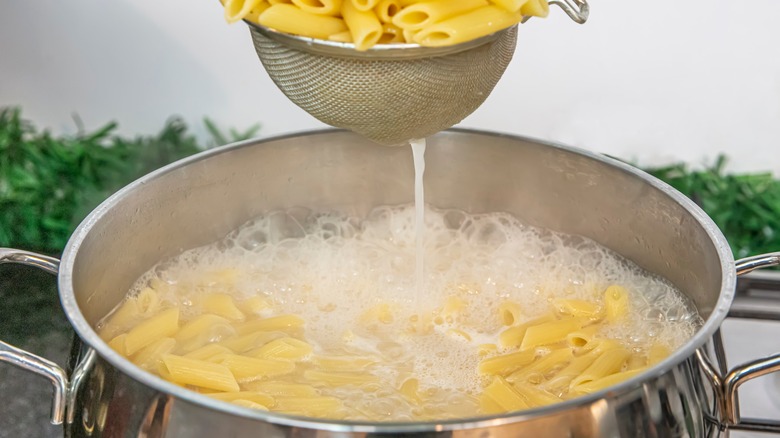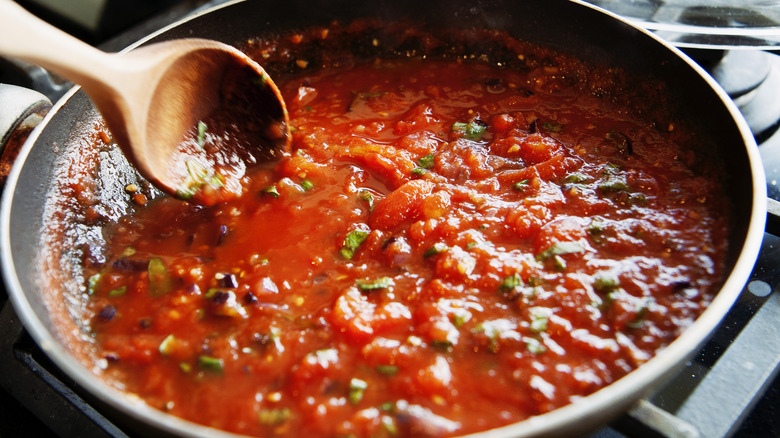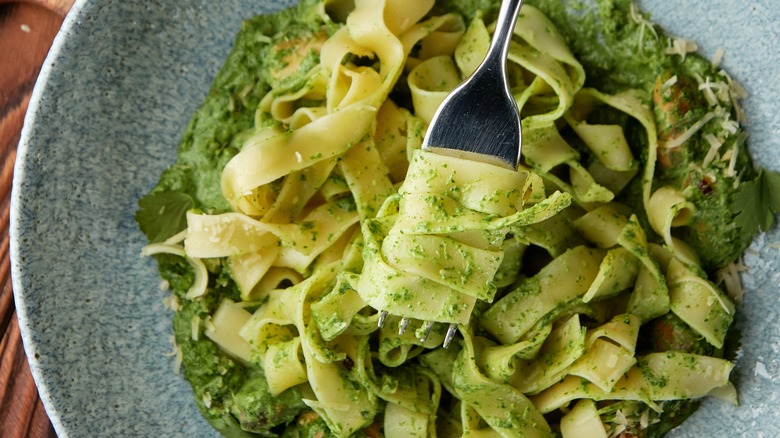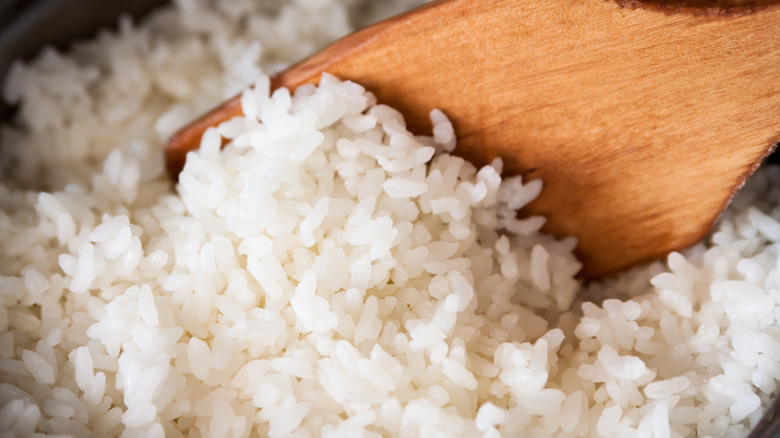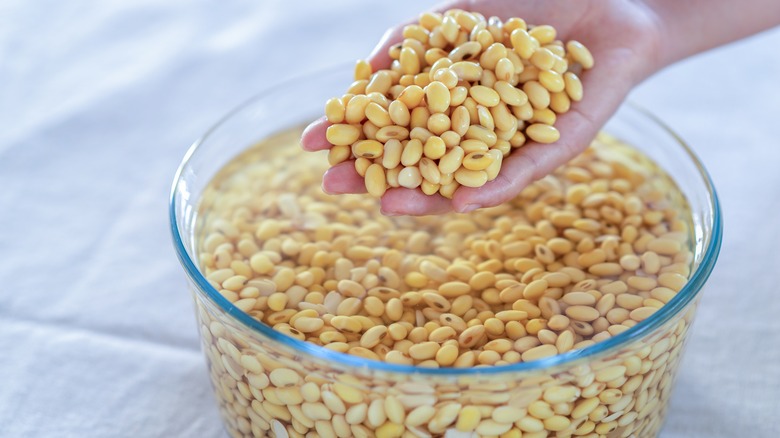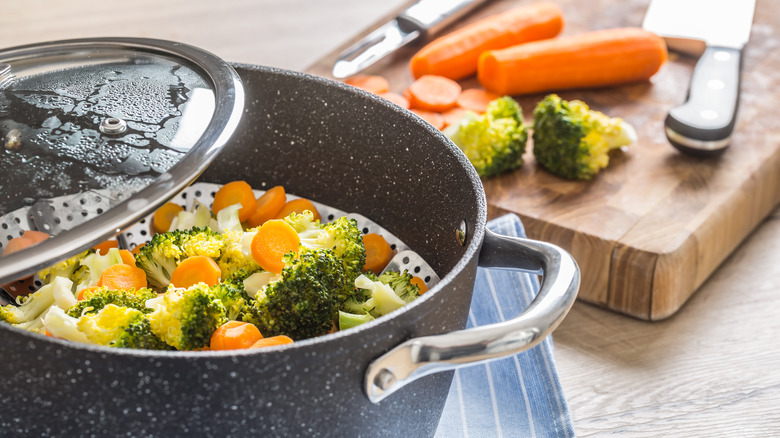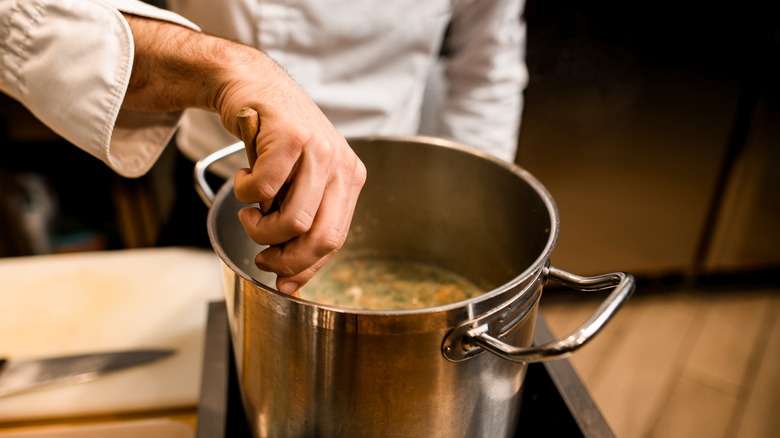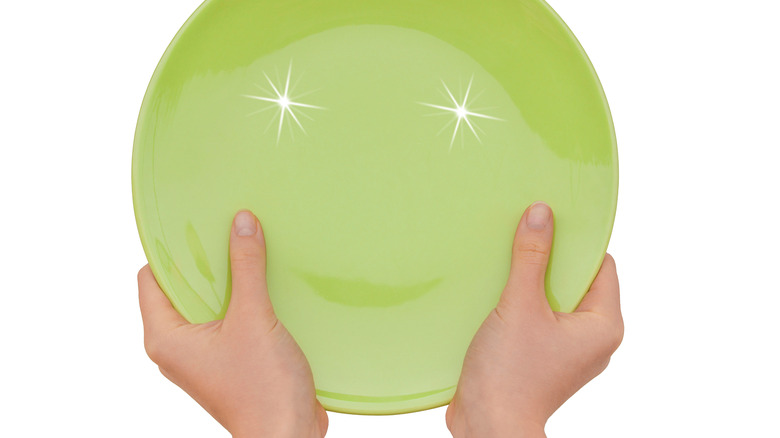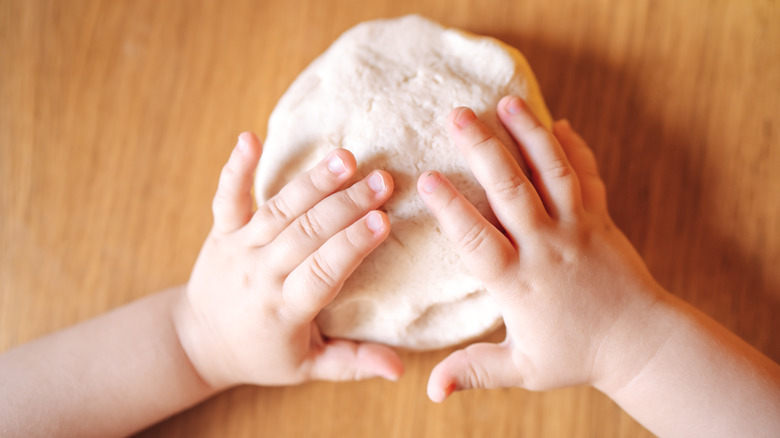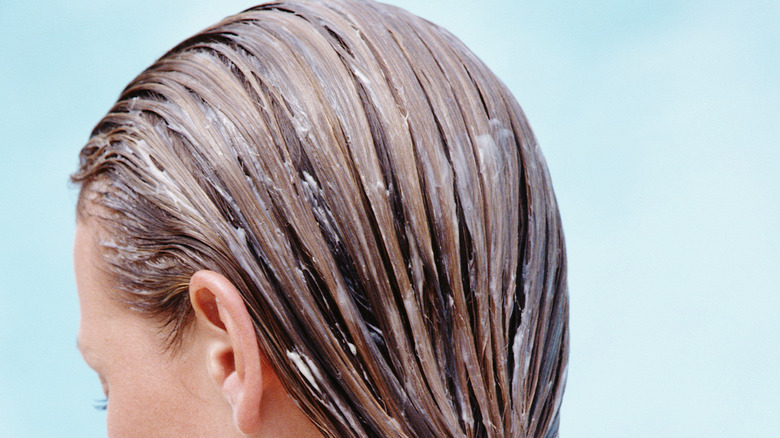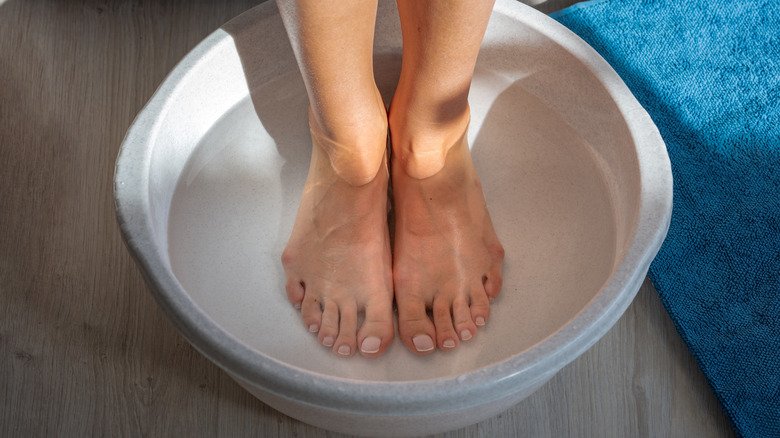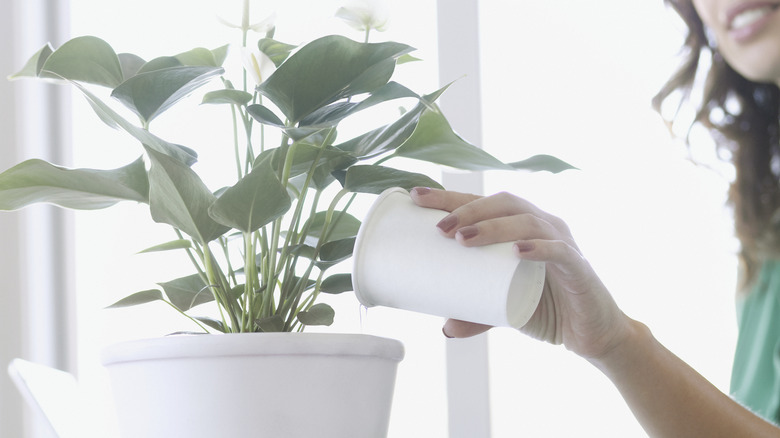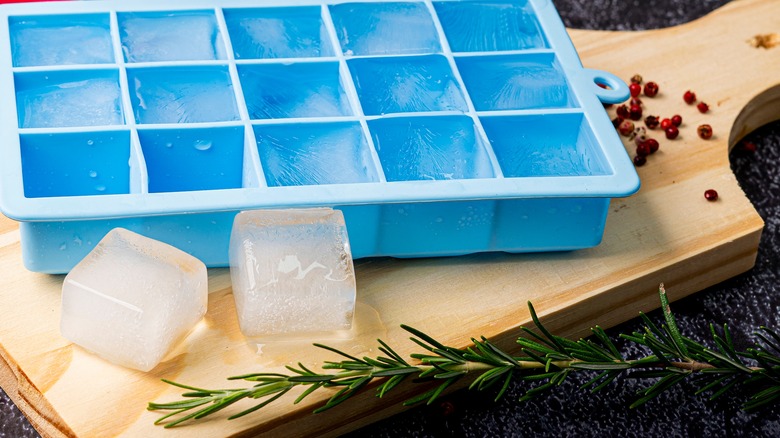13 Uses For Leftover Pasta Water You Need To Know
You've cooked up a pot of pasta, and now you have that filmy, telltale ring, thanks to those minerals and starches in your now cloudy water. Yep, another pot to scrub. But that starchy residue means your leftover pasta water will be useful, in more ways than one. It can have some practical benefits for you and your kitchen if you know what to do with it. So, keep it instead of tossing it and save time and conserve water, too!
Did you know you can use some of that leftover pasta water to clean your pasta pot? What's more, it can make your meals more fragrant and appealing. Using a small amount of this salted, cloudy water in your sauces, soups, or stews can lift their flavors without imparting too much saltiness. With the starch it has accrued, it will help to thicken them, too (and keep them silky and smooth). And its benefits extend beyond the kitchen! Read on to learn why you should be saving your leftover pasta water and how best to use it.
It's a great thickener for sauces
Cooking Light refers to pasta water as "liquid gold." It not only supports the cooking of your pasta, but it also benefits your sauces, too! And by the way, when cooking, you only need just enough water to cover the pasta. So, with that in mind, not only can you conserve water, but you can also make a mouthwatering dish by repurposing the pasta water, too!
After your pasta is done cooking, scoop some leftover pasta water into your sauce. The starch in the pasta water acts as a thickener and pulls the sauce together — giving it that restaurant-quality appeal. It provides a silky, smooth texture with a slightly richer flavor — and it won't make your dish overly salty. The trick is to add your pasta water to the sauce, mix it well, and then add your cooked pasta. This will also keep the sauce from slipping off your noodles, and that's true for pesto, as well.
It will keep your pesto from slipping off your noodles
Ever made your own pesto pasta, only to take a bite and end up with just a slippery noodle or two? In other words, your pesto has run off, leaving you with a forkful of noodles and a puddle of pesto on your plate?
Keep them together with a seamless, simple method: You just need a bit of your leftover pasta water. The starchiness of the pasta water will help the noodles and pesto stick together so that you can enjoy the dish as it was intended. So, reserve some of that liquid. Slowly mix a few tablespoons of pasta water into the pesto to meet your desired consistency. You may use a little more or less, depending on need. But be sure to do this off the stove. High heat will impact the fresh aroma of your basil and cause it to brown. The residual heat of the pasta water, on the other hand, will be fine for keeping the intense, bold flavor.
It's useful for cooking rice and other grains
Using leftover pasta water to cook another batch of pasta may seem like a great idea, but you may find it that it leaves your pasta a bit sticky. If that's what you like, however, go for it! Another option is to reuse that pasta water for cooking rice later in the week. (Leftover pasta water can last you a few days when sealed properly and stored in the fridge.) So, this is both a meal-prep option and a way to conserve water.
In fact, when you use that slightly viscous and mildly salty water, it will help flavor up a pot of otherwise bland rice or grains (via Life's Little Sweets). It you are making a rice recipe that requires some salt, you can use a little less (and just add a wee bit to taste if necessary). And note, if you prefer rice that you can easily grab a forkful of (aka the kind that sticks together), this is a good way to get that dense, starchy appeal.
It's ideal for a crisp pizza crust
Can't decide between pizza or pasta? Make that pasta first and save your leftover pasta water for making your pizza's crust the following day. You'll simply swap out the regular water for the pasta water. Why? Because the starchiness of the pasta water is ideal for ensuring crisp, golden results (via Life's Little Sweets).
Need a good recipe for your pizza's crust? If deep dish is your jam, you'll love Mashed's deep dish pizza recipe. Prepared with all-purpose flour, cornmeal, kosher salt, a wee bit of sugar, instant yeast, butter, and lukewarm water (we highly suggest you reuse that pasta water), it's a dough you'll have to chill and allow to rise (twice) so that it leavens properly. You'll not only get crisp outer edge, but you'll also have the perfect chewy base for each mouthwatering bite. And if you're looking for a dough that's less needy, try Mashed's quick no-knead pizza recipe to save you some time. Again, don't forget to use that pasta water. (Just be sure to warm it first.)
It'll help soften your legumes (and make them more digestible)
Legumes can be hard to digest, especially if you don't cook them properly. Their fiber and starch are absolutely a nutritional benefit, not to mention their B vitamins and other essential nutrients (via Medline Plus). But dried beans and legumes may come out chewy if you don't prepare them properly, so, to make them more tender and more digestible, soak them in your leftover pasta water along with a bay leaf or two (via Cookist).
Soaking dried beans shortens their cooking time (preserving more nutrients for your body to absorb). It does so by removing the oligosaccharides (indigestible sugars) which can also cause bloating (via NYC.gov). As a bonus, it also helps them cook more evenly (via Food Above Gold).
Using salted water helps to shorten the soak time, and when you use leftover pasta water, you already have the power of brine. And you don't need to worry about sodium because the salt in the "brine" doesn't add much sodium to the beans. Rather, it softens the pectin in their skins, allowing them to absorb water more quickly. You'll get a softer, more creamy texture, and the beans will be less likely to split when you cook them.
It's perfect for steaming your vegetables
Pasta is a great vehicle for veggies, whether you choose to eat them on the side, mixed into buttered noodles, or smothered into a hearty sauce for your penne pasta. And what better way to conserve some water and energy than by using your leftover pasta water to steam your veggies! It's best to begin the steaming while your leftover pasta water is already hot in the pot. This way, it will take less time to reach a boil, and then you can add the steamer with veggies on top. By the way, we love the steaming our vegetables. Steaming retains the nutritional value of your vegetables, as some vitamins and minerals will leach out if you boil them (via Cookist).
Want to save more time? You can place your steamer above the boiling pasta and cook both at once (via Uno Casa).
It's a terrific base for your soups and stocks
One of the magic ingredients you'll find in a restaurant-worthy soup is a mineral called salt. It is one of several components that build upon each other for a flavorful soup. Additional flavor enhancers can include tangy tomatoes, fresh or dried herbs, and even parmesan rinds, as soup is the ideal vehicle for a pantry-friendly dish and a leftover-friendly meal.
As for salt, leftover pasta water automatically brings it to a broth combo. In fact, chefs often rely on pasta water for their broths (via Fine Diving Lovers), since it's a convenient way to elevate their flavors and textural properties. As a natural slurry (i.e., a mixture of starch and water), it is an ideal thickening agent for a soup or stew, not to mention one that takes away that extra step of whisking cornstarch and water in a small bowl. And yes, a slurry is necessary, because if you add starch directly to your pot of liquid, it will clump.
It can thin out condiments for spreadability
Your leftover pasta water may help to thicken your sauces and soups, but it may also be used to thin out your condiments (via Cookist). This might sound oxymoronic, but pasta water can serve either purpose. Think of those pestos and sauces that have coagulated in your fridge; they might need some thinning out for better distribution, such as to drizzle, pour over, or glaze a dish. But you wouldn't want to simply add water, as that would dilute the sauce's flavor. Grab some pasta water instead — it has the power of flavor and starch!
Pasta water won't dilute the flavor in your sauces nor make them too runny, and it may also add some silkiness to your condiment or glaze. Just be sure your pasta water is warmed before adding it to your sauce or condiment. Use a little at a time and mix well to get your ideal balance for spreadability or pouring.
It can be used to clean your dishes
Use that leftover pasta water to clean that starchy ring it left in your pot (yes, the very substance that created that residue). It may sound surprising, but pasta water can be used as detergent. It is also a great way to conserve water when cleaning your dishes, but use it while it's still hot. The hot pasta water helps remove crusty grime and those oily fats, too (via Cookist). Simply plug your sink (or use a basin tub) and allow your dishes to soak in the warmth of the pasta water. Then, wash as you would regularly or put them in the dishwasher. This extra step can save you scrub time and keep your dishes looking like new.
So just how does this work? Starchy water works as an abrasive (via Apartment Therapy). It's one of the reasons people reach for cornstarch to help remove that "stuck-on" residue that may otherwise be difficult to remove.
You can use it to make play dough
Why do some people use cornstarch (aka cream of tartar) when making their own play dough? It's because it gives dough that elasticity for a smooth and pliable mound (via Yale-New Haven Teachers Institute). But if you're planning on making some pasta, you can use the leftover pasta water instead.
The traditional recipe is quite simple and closely resembles one that was originally created to clean wallpaper before becoming popularized in the 1950s as Play-Doh. Trivia aside, the basic ingredients include flour, salt, and water. Simple enough, but if you don't have the right proportions, you could end up with a solid rock or a sticky mess. And, you'll be using plenty of salt. Salt is necessary to strengthen the flour's gluten bonds so that it all comes together without being sticky. It helps as a preservative, too, to prevent molding. Note that the dough can easily dry out if left out of a well-sealed container. The solution: a conditioner — i.e., cornstarch or, better yet, your pasta water.
For a smooth, pliable dough, try our edible play dough recipe. It uses 1½ cups of flour, 1 cup of salt, 2 tablespoons of vegetable oil, ¼ cup of cream of tartar, and 2 cups of water. Don't have cream of tartar? Swap out an equal portion of your tap water for pasta water to get similarly smooth results.
You can condition your hair with it
Who doesn't want smooth and silky hair? You could spend a lot of time and money seeking the right conditioners, but you've likely got all that you need at home. Go to your pantry, grab a handful of pasta, and boil just enough water to cover it. Yes, we're asking you to make yourself some pasta and save that leftover pasta water for your hair. Why not? Historically, rice water has been used in both Japan and China to maintain long, strong, silken hair (via Famina). And pasta water can have similar benefits.
It is said that the starch and essential vitamins in rice water help strengthen, moisturize, and increase the shine in your hair (via InStyle). Pasta water also adds a protective coating of starch and contains beneficial nutrients, too — some of the B vitamins added to pasta will leach out of the pasta when you cook it, according to Miller Magazine, including vitamin B2, aka riboflavin. Riboflavin not only increases blood circulation, but it also activates vitamins B6 and niacin for a healthier scalp and hair (via Mark Birch Trichologist). Plus, pasta water has the benefit of salt. Salty water can act as a gentle scalp exfoliator to help strengthen your hair (via Prevention). And regarding the starch component, yep, that, too, can leave it silky smooth.
For best results, wash and rinse your hair first before adding your starchy water (via InStyle). Start at the roots and work your way up. Then let it sit 20 to 30 minutes before rinsing.
It's a good foot soak
Epsom salt is often used to alleviate sore muscles and soothe pain. Adding a scoop to your warmed foot bath is great for a healing soak. But if you don't have Epsom salt, any salt is good in a pinch (via Select Salt). Your leftover pasta water will work, too, because it still contains sodium chloride. So, you can still heal those sore feet after a long, hard day.
A natural exfoliant and muscle relaxer, salt can ease inflammation, sooth your muscles, and leave your feet soft and smooth. As for your leftover pasta water, it contains salt and will still have some residual warmth from the cooking if you use it right away, not that it isn't easy enough to re-warm.
Pasta water also contains the minerals that have leached from the pasta, which can have relaxing, soothing qualities, too (via Uno Casa). So, prepare a comforting pasta meal and use that leftover pasta water for an at-home foot spa.
You can use it to water your plants
You already know that leftover pasta water has a variety of uses, not to mention the cooking process infusing nutrients into the pasta water. Even if you already repurpose it for your hair, to clean dishes, or to enhance your cooking, you may be overlooking another potential benefit: Your leftover pasta water can nourish your plants, too (via Succulents Box).
Some of the leached-out nutrients in pasta water include riboflavin, niacin, thiamin, calcium, and iron. And let's not forget that concentration of starch (aka carbohydrates), which plants need, too. In other words, your leftover pasta water is a natural fertilizer — and, as a bonus, it contains no potentially harmful substances. Similar to composting, you can use it to complement any fertilizing you already do. So, go ahead and use your pasta water to water your plants (once it has cooled).
Storing your leftover pasta water
If you plan on storing your pasta water, just be sure to cool it first. It should last up to three days in a well-sealed container in your fridge (via Uno Casa). Beyond that, it may become more of a science experiment, so label it, keep it visible, and aim to use it (or lose it). But if you want its potential to extend even longer, you can certainly freeze it, too. For easy access and convenient portions, freeze pasta water in an ice cube tray. You will likely need no more than a couple of cubes to thicken and smooth out your sauces or add to soups and stews. You can use it as you would a bouillon cube — ideally heating your sauce or liquid first.
If you'd like to freeze a larger portion of your pasta water, consider storing it as you would soup. You can decant your cooled pasta water into freezer-friendly containers (think Ball mason jars, glass- or BPA-free airtight containers, or gallon freezer bags) and then label it and store it for up to three months (via Better Homes and Gardens). It's ideal to thaw the pasta water in the refrigerator for a day or two before using.
